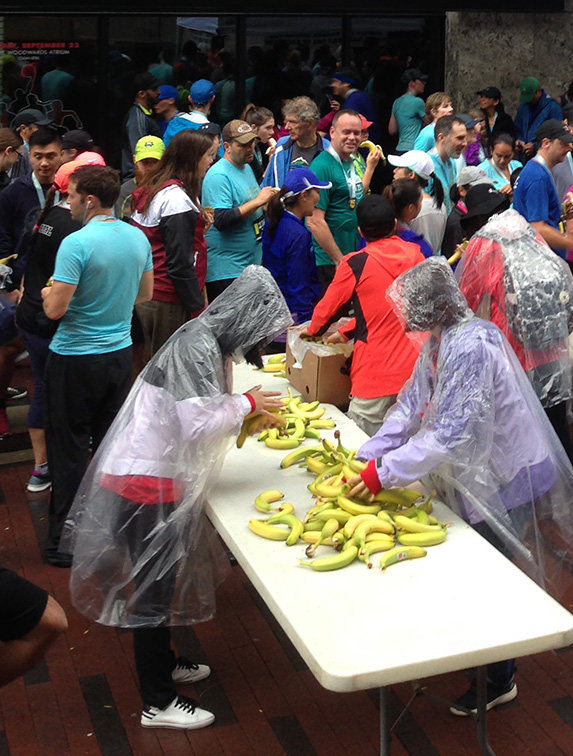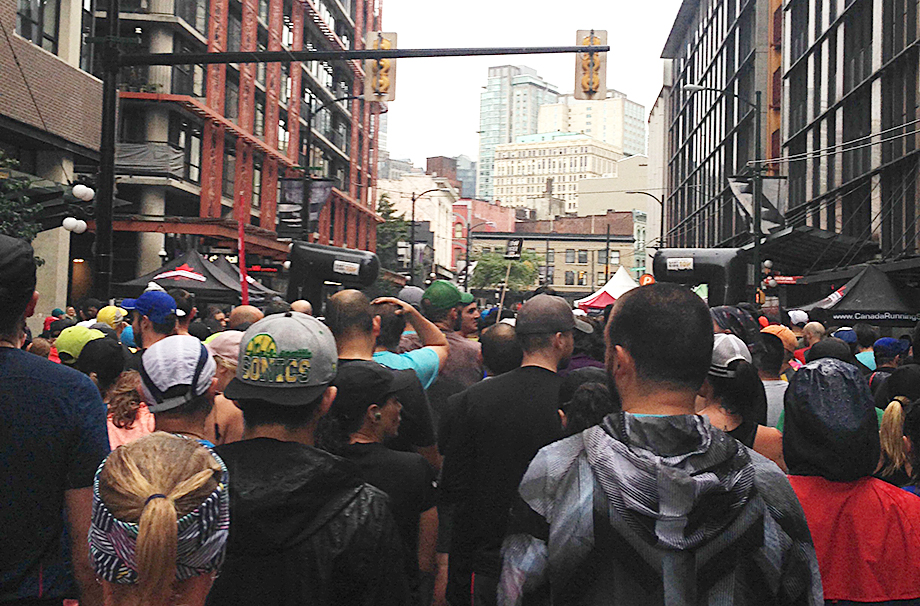I stood in the starting corral for the Vancouver Eastside 10k. I’d opted to pocket my house key and keep my windbreaker, so I dropped the two loonies I had brought for the bag check — decidedly not worth the jingle as I ran.
“Excuse me, I think you dropped some money!”
I turned around to the runner behind to explain what I thought was my overt disposal of the currency.
“I know,” I said with my palms raised to shoulder height in an apologetic surrender. “I can’t be bothered to carry it. Hopefully someone that lives here picks it up.”
“Ah, a true donation to the neighbourhood!”
One can hope. Though I anticipated it would more likely buy half of someone’s latte.
‘A run in, for, and with the Eastside’
Dosed on caffeine from a hybrid of coffee and maté that jolted me forward from my far-from-characteristic 5:30 a.m. wake-up time, I arrived at the event area 15 minutes before the race in search of what turned out to be a full block of portable toilets, controlled by a man in a reflective vest rapping the doors with an illuminated traffic wand before signaling in the next runner.
This block was a substantial upgrade in amenities from the usual four public washrooms in the entire Downtown Eastside.
Sponsored by the athletic brand Under Armour, the run was marketed with the tagline “A run in, for, and with the Eastside,” with the option to fundraise for the Downtown Eastside Women’s Centre, the PHS Community Services Society or the Greater Vancouver Food Bank.
The city worked to facilitate the event, closing the roads for the course from the Downtown Eastside to Hastings Sunrise for two hours.
The course description in the Run Guides directory painted a picture of a newly gentrified neighbourhood being coaxed into a real estate opportunity: “With a Gastown/Strathcona course, runners can expect a heritage/industrial feel to things, and get to run along sections of the city that are rarely closed off to traffic... giving runners some new looks to think about.”
The streets adjacent to the starting point were closed to make room for sponsor tents and the crowd of runners temporarily crammed outside the Woodward’s Building. The contentious mixed-housing development seemed to speak for all the confused forces coming together at the run — the corporate interests, municipal sponsors and middle-class enthusiasts assuming control of a low-income neighbourhood — privilege waltzing with social justice.
I admit the circuit was probably part of the appeal for me — my staple run goes from Hastings Sunrise to New Brighton Park. But traversing the city by foot proved more loaded when I wasn’t an autonomous unit, but part of a mass arguably running for a community that had been pushed to the sidelines to facilitate us.
Uncomfortable philanthropy
As I navigated toward the start line, a man (sans running bib) wove his way dexterously against the crowd’s flow, his wide eyes filled with the odd circus that had taken over the neighbourhood. He threw his hand forward with a cascade of laughter, briefly slicing through the hubbub with his reverberation.
He made a good point. The whole charade felt in many ways discontinuous, like ridiculously loud wallpaper had been steam-pressed onto the street.
After eight minutes bogged down at the starting line the race began, and I wove through the markers along the 10-kilometre circuit. Members from local urban running clubs waved flags to cheer on their participants, photographers with expensive cameras and lenses snapped photos. People whose relationship with the neighbourhood seemed displaced by mine appeared at the periphery.
I viewed the world beyond the fence as though on a carousel — unreachable as I circled from the vantage of my well-postured horse. In this river of athletic gear, branding, competition and privilege cast upon the backdrop of the neighbourhood, I felt nausea. It seemed an Ayn Rand, dog-eat-dog version of running as a metaphor for capitalism, clumsily dressed in a guise of inclusivity and community.
Don’t get me wrong: I was motivated to participate in the run as a personal athletic goal, and so, I expect, were most of the participants. I’d only pledged to run for the Downtown Eastside Women’s Centre a few weeks before, and I received gracious donations from friends and family who generously supported my effort and the cause. Ultimately, I was glad to raise the funds for the centre.
Yet I felt I’d stumbled into an uncomfortable version of philanthropy. By seeking donations, the promotion of my effort was co-opted through a charitable cause that served to bolster my personal agenda.
At the five-kilometre mark a woman yelled, “You’re all amazing!” I was unsure as to whether she was being sincere or sarcastic, but so arose the uncomfortable yet transparent pang: I’m not here ‘with’ you.
Despite the run’s slogan — “A run in, for, and with the Eastside” — I didn’t feel close enough to speak on behalf of the people who lived there, but also seemed to assume I was entitled to a spotlighted run through their neighbourhood. In the end, $17,552 was raised for the Downtown Eastside Women’s Centre, though it felt that for the charitable cause to be successful, the project had to give the runners precedence.

The fault line
At the end of the run I stood on the stairs above the refreshment tents, overwhelmed by the buoyancy and adrenaline of the crowds. I consumed a complementary banana and rice bar.
A man (sans bib) stood a couple steps above me, arms filled with yogurt packs he had stealthily extracted from the backs of the tents as the volunteers were focused on the flood of runners pouring in from the finish line. Beyond him were the pop-up info tents for the charities affiliated with the run. They were mostly empty.
The take-home message didn’t seem to be a run “for” the neighbourhood. It seemed to say: Take a picture in the neighbourhood, eat a banana, and go home.
There was a fault line between the run and its charitable guise. The event operated to serve the interests of the participants, and as a byproduct, raise money for a community — a good symbol of the multifaceted complexity of the disparity between the two worlds.
Thank you for your streets. I ran 53:36. ![]()
Read more: Rights + Justice, Municipal Politics
















Tyee Commenting Guidelines
Comments that violate guidelines risk being deleted, and violations may result in a temporary or permanent user ban. Maintain the spirit of good conversation to stay in the discussion.
*Please note The Tyee is not a forum for spreading misinformation about COVID-19, denying its existence or minimizing its risk to public health.
Do:
Do not: